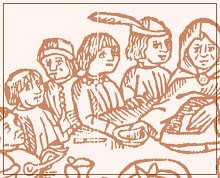A few points of interest in this Middle English Yorkshire (?) chronicle, from c. 1327 (it goes up to the coronation of Edward III)! Quite aside from the fact that it seems unaware of the (supposed) murder of Edward II in September of that year, I suspect an early date due to its entire failure to adhere to the expected narrative pattern for the last few years of Edward II’s reign.
(All quotes are by line number from Caroline Eckhardt’s EETS edition – Castleford’s Chronicle, or The Boke of Brut, EETS 305-6 (1996), volume 2 of 2.)
For a start, the Despensers are not mentioned once in the narration of the civil war (well, skirmishes) of 1321-22. Despite the fact that they are the main point of contention (or the symbol of it) between the barons and Edward, and that contemporary chronicles habitually just blame them for the whole. Unless they are pro-Edward, in which case it’s either all deeply unfortunate, or Lancaster’s fault. But that’s not the case here – the chronicler is not too fond of Edward, and Lancaster is referred to (at least in the rubrics, although they could be scribal rather than authorial) as “Saynt Thomas” (39320). It’s uncertain whether the author would have participated in the martyr-cult language, as there is a very inconvenient folio missing between the capture of Lancaster at Boroughbridge and the invasion of Isabella in 1326, but in the text as it stands there is no overt sanctification of Lancaster – he’s merely the leader of the barons, and his virtues are not extolled above those of any of the others.
So, no Lancaster-villain or (probably) Lancaster-martyr, and very little Despensers. Possibly the Despensers were mentioned in the height of their power between 1322 and 1326, but, missing folio. When the Despensers are mentioned... well, here’s the real surprise. They aren’t villains.
In Bristoln, Huge Spenser þe alde,
In Bristol, Hugh Despenser the elder
So noble a knight hade bene and balde,
[Who] had been a knight so noble and bold,
Wi3 horses draghen, his domes slik,
[Was sentenced to be] drawn by horses, his doom/sentence being such
And siþen his heide of to strik.
And then his head to be struck off.
And Huge Spenser, þe yonger knight,
And Hugh Despenser, the younger knight,
For he in lande bare him noght right,
Because he in the land behaved not rightly
Sum men said, wrang consail[d]e the kynge,
Some men said, counselled the king ill
Þai dampnede him to draugh [and] hyng,
They damned/sentenced him to draw and hang…
(Castleford’s Chronicle, 39376-383)
This comes in the context of the author’s account of the “ful grefe suffrede þat tim” by all the supporters of Edward II. It is, in fact, almost sympathetic. And, although the chronicler is not entirely sure whether young Hugh’s character is entirely spotless, he isn’t the evil evil villain of evil scheming doom that he so often becomes, and the chronicler even praises the knighthood of the older Hugh.
The chronicler goes on to tell, with equal sympathy, of the deaths of Edward II’s other principle pillars at this time: Arundel, Baldock and Bishop Walter Stapelton of Exeter. The first two were executed by Isabella (no mention is made in this chronicle of Mortimer, unless it is in that missing folio), but, upon the news of Edward’s capture, Stapelton was killed by a London mob before Isabella even approached the city. Doubtless he would have been executed anyway, but as it was, the queen was not directly responsible for his death. Interestingly, however, this chronicle makes no distinction between execution (however doubtful its legality) and mob violence. ‘Death came to each of these five men in these ways’, it says, rather than ‘four of these men were executed and the Londoners rose up against the fifth’. The manner of each is narrated as if all stemmed from a common cause.
Þe bishop of Excestre, Walter,
The Bishop of Exeter, Walter,
Þat was þe kynges tresorer,
Who was the king’s treasurer
In London, at þe strete of Chepe,
In London, on Cheapside
Smote of his heide, noght els to threpe,
His head [was] smote off, with no further ado,
Amanges rascaile of þe cite,
Among the rabble of the city
And oþer wele fele wi3 him to se.
And others very many with him to be seen.
(Castleford’s Chronicle, 39396-401)
And, for completion, the chronicler’s summary of Edward II’s character. Note that crop failure during his reign is entirely an aspect of his character as king. Poor Edward.
Þis Edwarde, als anens his lede,
This Edward, as regards his rule,
Was wis of worde ande fole in dede.
Was wise in word and fool in deed.
Ek he was ful vngraciouse man,
Also he was a full ungracious man, [lit. lacking God’s grace; possible connotations ‘unnatural’, ‘wretched’, ‘wicked’]
Wel ner in alle þinges he bigan;
Well near in all things he undertook;
He gaf him, þof it semede no3 wele,
He devoted himself, though it did not appear well,
To al kins werke manuele.
To all kinds of manual work.
Durande alle his daise wel ner
During almost all his days [as king]
Chepinge of al kins corn was dere,
Purchase of all kinds of grain was expensive,
Feldes failede, vngre was grete,
Fields failed, hunger was great,
Poueraile diede for defaute of mete,
The poor died for lack of food,
Morin of men, of bestes alsua,
[There was] widespread death among mean, and beasts also,
Alle Englande in contek and wa,
All England [was] in discord and woe,
Alle Englande in contek and strife,
All England [was] in discord and strife,
Na pes stabliste durande his lif.
He established no peace during his life.
(Castleford’s Chronicle, 39412-425)


.jpg)

